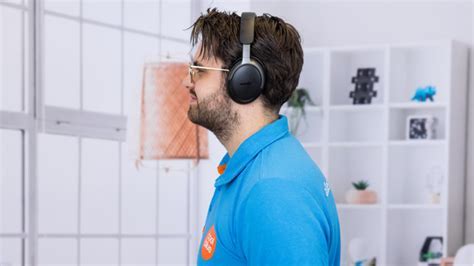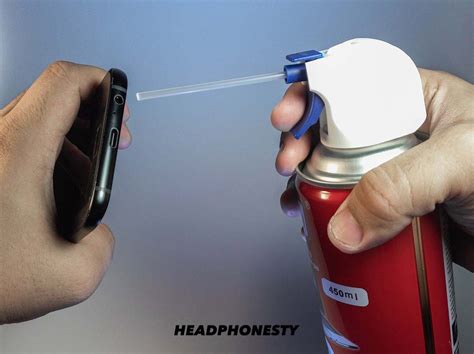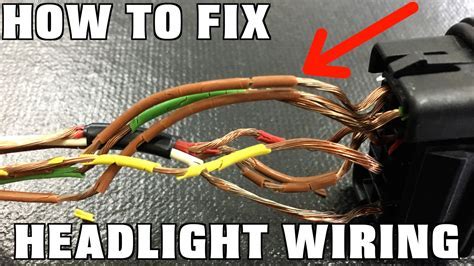Have you ever experienced the frustrating issue of imbalanced audio in your headphones? It can be quite annoying when one earpiece is noticeably quieter than the other, impairing your listening experience. Whether you enjoy immersing yourself in music, watching movies, or playing video games, having equal sound quality in both headphones is essential to fully enjoy the audio content.
Uneven volume levels in headphones can be caused by various factors, such as hardware malfunctions, improper audio settings, or even the type of audio source you are using. Luckily, there are several techniques and troubleshooting steps you can follow to rectify this irritating issue and restore the equilibrium to your listening experience.
If you find yourself constantly adjusting the audio balance on your device or uncomfortably swapping the headphones between ears to compensate for the volume difference, it's time to take action. With the help of the following tips and tricks, you can regain the perfect balance of audio in your headphones and enjoy your favorite music, movies, or games without any distractions.
Solving the Issue of Uneven Headphone Volume

Having a pair of headphones with uneven volume can be frustrating and disrupt your listening experience. In this section, we will explore effective methods to rectify this problem and ensure balanced audio in both earbuds.
Identifying the Imbalance:
The first step in solving the issue of uneven headphone volume is to identify which earbud is playing at a lower volume. This can be done by playing a test audio track and paying close attention to the sound intensity in each ear. Once you have determined which side is quieter, you can proceed with the appropriate solution.
Adjusting the Balance:
If the imbalance is caused by a system setting or configuration issue, you can easily fix it by adjusting the audio balance settings on your device. This can usually be found in the sound or audio settings menu. By shifting the balance control towards the quieter earbud, you can bring the volume levels to a more even level.
Cleaning the Headphone Jack:
Sometimes, the issue of uneven volume may be due to dirt or debris accumulated in the headphone jack. Cleaning the headphone jack can help improve the connection and ensure uniform sound output. Use a small, clean brush or a cotton swab dipped in rubbing alcohol to gently clean the jack.
Checking the Audio Source:
Another possible cause of uneven headphone volume is the audio source itself. Sometimes, the audio file or media player may have imbalances in the stereo mix, resulting in unequal volume distribution between the left and right channels. To test this, try playing different audio tracks or using a different media player to see if the issue persists.
Earbud Maintenance:
Uneven volume can also be caused by physical damage or wear and tear on the earbuds. Check for any visible damage, such as frayed wires or loose connections. If you notice any issues, it may be necessary to replace the affected earbud or consider getting a new pair of headphones.
Professional Assistance:
If none of the above solutions resolve the issue, it is recommended to seek professional assistance. A professional technician or audio specialist will be able to diagnose and fix any internal hardware or component defects that may be causing the uneven volume.
By following these steps, you can effectively solve the problem of uneven headphone volume and enjoy a balanced audio experience. Remember to try each solution methodically, and don't hesitate to seek professional help if needed.
Diagnosing the Issue: Identifying the Quieter Headphone
When facing the situation where one earpiece of your audio device is producing lower volume than the other, it's important to identify the specific earpiece that is experiencing the issue. By understanding how to diagnose this problem, you can effectively troubleshoot and resolve the imbalance.
Start by wearing the headphones and playing audio content. Pay close attention to the volume in each ear and take note of any noticeable differences. Observe if the sound is consistently softer in one ear or if it intermittently fluctuates. This initial evaluation will provide valuable clues in pinpointing the problematic earpiece.
Next, conduct a physical examination of the headphones. Check for any visible damage or loose connections, such as frayed cables or bent audio jacks. Ensure that the ear cushions are properly sealed against your ears, as improper positioning can result in unequal sound distribution.
If the issue persists after these initial checks, proceed to perform a left/right audio channel test. This can be done by playing audio files specifically designed to test each ear individually. As you listen, note which side has a noticeable decrease in volume or clarity.
Another useful technique is to cross-check the earpieces. Swap the left and right earpieces, placing the right earpiece on your left ear and vice versa. Pay close attention to any changes in volume or sound quality. If the issue persists but switches to the other ear, it indicates a problem with the swapped earpiece.
Additionally, it is advisable to try the headphones on another audio device to determine if the problem lies with the headphones or the source device. Connect the headphones to a different device and assess if the imbalance persists.
By carefully diagnosing and identifying the faulty earpiece, you can take appropriate steps to resolve the issue and restore a balanced audio experience. Remember to utilize the above techniques and observations to troubleshoot effectively and enjoy optimal audio quality.
Cleaning the Headphone Jack: Ensuring No Dirt or Debris

When it comes to resolving the disparity in audio levels between two headphones, one common culprit is a dirty or dusty headphone jack. A build-up of dirt, debris, or even pocket lint can interfere with the proper functioning of the jack, leading to imbalanced sound output. Therefore, it is essential to regularly clean the headphone jack to ensure optimal audio quality.
Clearing out any foreign particles from the headphone jack can be a straightforward process. Begin by turning off and unplugging the headphones from the device. Gently inspect the jack, looking for any visible dirt or grime. To clean it, you can use a soft-bristled toothbrush, a cotton swab, or a small, clean brush specifically designed for electronic devices.
Warning: Before proceeding with cleaning, always ensure the headphones are disconnected from any power source and the device they are connected to.
Take the chosen cleaning tool and carefully remove any visible debris from the headphone jack. Using gentle, controlled motions, brush or swipe around the edges of the jack, ensuring not to push any dirt further inside. Be cautious and avoid using excessive force, as this could potentially damage the delicate pins inside the jack.
For more stubborn dirt or debris, you can slightly dampen the tip of a cotton swab or cloth with isopropyl alcohol. Again, exercise caution and ensure the swab or cloth is only slightly damp, not dripping wet. Gently swab the interior of the jack, being careful not to leave any residue behind.
Once you have finished cleaning, allow the jack to dry completely before reconnecting the headphones. A dry lint-free cloth can be used to remove any excess moisture. Afterward, you can plug in your headphones and test the audio levels to see if the issue of one headphone being quieter than the other has been resolved.
Remember, regular maintenance and cleaning of the headphone jack can help ensure consistent sound quality and prevent imbalances in audio output.
Checking Audio Settings: Adjusting Balance and Volume
Properly adjusting the balance and volume of your headphones can help resolve any imbalances in sound output between the left and right channels. By making sure both channels are set to an equal level, you can ensure a more enjoyable listening experience.
Firstly, locate the audio settings on your device. This can usually be found in the control panel or settings menu. Once you have found the audio settings, look for options related to balance and volume control.
Balance control allows you to adjust the distribution of sound between the left and right channels. If one earpiece is quieter than the other, try moving the balance slider towards the quieter side to increase the volume. Experiment with different settings until you achieve a balanced sound output.
In addition to balance, volume control is another important setting to check. Make sure both the left and right channels are set to the same volume level. If one channel is significantly louder than the other, adjust the volume control accordingly to achieve a balanced audio output.
After making any adjustments, it is advisable to test the headphones with audio that features distinct left and right channel elements. This can be a stereo sound test or a song with prominent instrument separation. Listen carefully to ensure both channels are now playing at an equal volume.
By regularly checking and adjusting the audio settings on your device, you can avoid the annoyance of one headphone being quieter than the other. Creating a balanced sound output enhances your listening experience and allows you to fully enjoy your favorite audio content.
Troubleshooting Wiring Problems by Replacing the Audio Cable

One possible solution to address the issue of headphones having imbalanced volume levels is to examine and potentially replace the audio cable. By doing so, you can identify and fix any wiring problems that may be causing one headphone to be quieter than the other.
Replacing the audio cable can help resolve issues related to poor connectivity, damaged wiring, or a faulty connection between the headphones and the audio source. Through this process, you can ensure a better and more consistent audio experience.
Before replacing the audio cable, it is important to first check for any visible signs of damage, such as frayed or exposed wires. Additionally, ensure that the audio cable is securely plugged into both the headphone jack and the audio source.
- Begin by gently detaching the audio cable from the headphones and the audio source.
- Inspect the cable for any signs of wear and tear, including any visible damage to the insulation or connectors.
- If necessary, purchase a new audio cable that is compatible with your headphones.
- Ensure that the new cable matches the required specifications, such as the correct plug size and connector type.
- Carefully connect the new audio cable to both the headphones and the audio source, ensuring a secure and snug fit.
- Test the headphones to see if the volume levels have been resolved and if both sides now produce a balanced sound.
- If the issue persists, consider seeking professional assistance or contacting the headphone manufacturer for further troubleshooting or repair options.
By replacing the audio cable, you can address any potential connectivity or wiring problems, resulting in a more enjoyable and balanced listening experience with your headphones.
Repairing or Replacing the Speaker: Dealing with Physical Damage
In this section, we will explore the steps to address any physical damage that may be causing one headphone to be quieter than the other. By examining and repairing or replacing the speaker, we can potentially resolve the issue and restore balanced sound quality.
- Inspect the speaker for any visible damage such as dents, scratches, or loose components.
- If there are dents, carefully try to reshape the affected area using gentle pressure.
- For scratches, consider using a suitable repair solution or covering the affected area with an adhesive sticker.
- If components appear loose, ensure they are securely fitted and tightened as necessary.
- If the speaker is wired, check for any damaged or frayed wires. Replace them if needed.
- If the speaker is detachable, remove it according to the manufacturer's instructions and inspect for any internal damage.
- For minor internal damage, consider using a specialized repair kit or consult a professional technician.
- If the speaker is beyond repair, it may be necessary to replace it. Contact the manufacturer or an authorized repair service for assistance.
Remember to exercise caution and refer to the manufacturer's instructions or consult a professional if you are uncertain about handling the repair process. Identifying and addressing physical damage to the speaker can potentially resolve the issue of imbalanced headphone sound and enhance your audio experience.
Seeking Professional Assistance: Consulting an Expert for Technical Resolutions

When encountering inconsistencies in headphone volume levels, it may be advisable to seek guidance from a professional who possesses expertise in audio equipment. By consulting a specialist, you can gain access to their extensive knowledge and experience in addressing technical difficulties related to headphones. A professional's assistance can prove invaluable in correctly diagnosing and resolving issues, ensuring optimal sound quality and an enjoyable audio experience.
Benefits of Consulting an Expert
| Choosing a Reliable ExpertWhen seeking professional help for headphone-related issues, it is crucial to select a reliable and reputable expert. Consider the following factors:
|
By seeking the guidance of a professional, you can effectively address the problem of imbalanced headphone volumes and restore an immersive audio experience. Their expertise, coupled with access to specialized tools and resources, ensures a reliable and long-lasting solution. Take the time to select a trustworthy expert who possesses the necessary experience and positive reviews, allowing you to confidently entrust your headphone troubleshooting needs to their capable hands.
[MOVIES] [/MOVIES] [/MOVIES_ENABLED]FAQ
Why is one of my headphones quieter than the other?
There can be several reasons why one headphone is quieter than the other. It could be due to a faulty audio jack, a loose wire connection, or an issue with the audio source.
How can I troubleshoot if one of my headphones is quieter?
To troubleshoot the issue, you can try several steps. First, check if the problem persists with another audio source or device. If it does, the issue might be with the headphone itself. You can also try swapping the left and right cables to see if the problem follows the same side. Additionally, cleaning the audio jack or replacing the cables might help.
Can a software problem cause one headphone to be quieter?
Yes, a software problem can sometimes be the cause of one headphone being quieter. It could be due to incorrect audio settings, audio balance settings favoring one side, or audio drivers needing an update. Adjusting the settings or updating the drivers might resolve the issue.
If none of the troubleshooting steps work, should I consider replacing my headphones?
If none of the troubleshooting steps fix the issue, it might be time to consider replacing your headphones. Sometimes, the problem is due to internal hardware issues that are difficult to fix without professional help. Consider investing in a new pair of headphones to ensure balanced and optimal audio quality.




